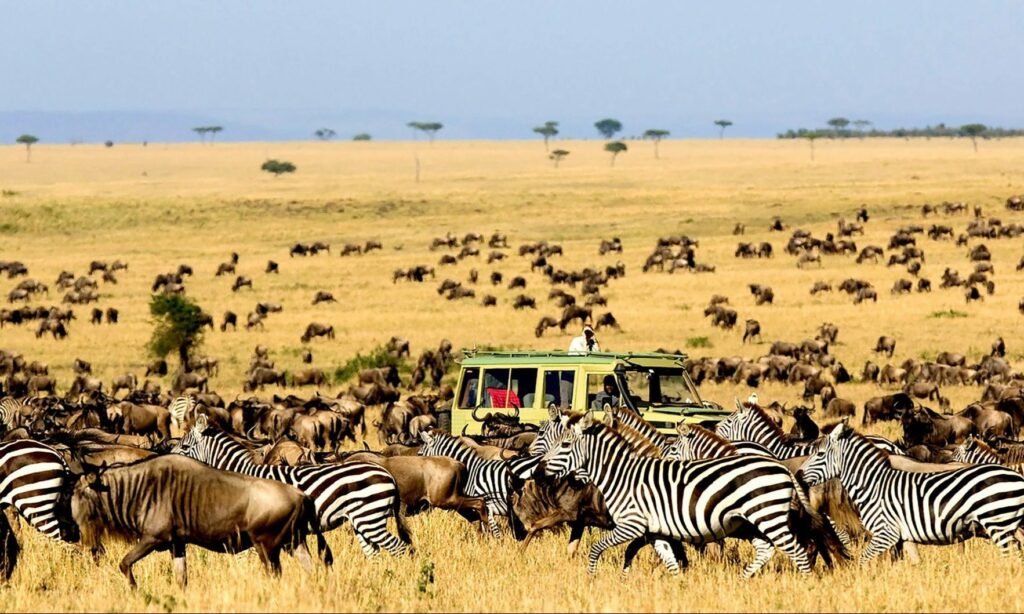The Serengeti: A Seasonal Safari Spectacle
The Serengeti National Park, a UNESCO World Heritage Site, is a place where the drama of the wild unfolds in a grand spectacle year-round. Each season in the Serengeti offers a unique experience, from the awe-inspiring Great Migration to the lush green landscapes teeming with newborn wildlife. Whether you are a wildlife enthusiast, a photographer, or simply someone seeking the adventure of a lifetime, the Serengeti has something to offer every traveler. In this comprehensive guide, we will explore the different seasons in the Serengeti and highlight the wildlife spectacles that make each period special.
The Dry Season: June to October
June to October: The Peak of Wildlife Viewing
The dry season, spanning from June to October, is often considered the best time to visit the Serengeti for wildlife viewing. During these months, the park transforms into a stage where the drama of survival plays out in full view.
The Great Migration
One of the most iconic events in the natural world, the Great Migration, reaches its peak during this period. From July to October, millions of wildebeest, zebras, and gazelles make their way northward, crossing the Grumeti and Mara rivers. These crossings are fraught with danger, as crocodiles lie in wait, making for some of the most thrilling and heart-stopping scenes in wildlife viewing. The herds often linger on the riverbanks, creating a tense atmosphere as they prepare to make the perilous crossing.
Wildlife Concentration
The dry season also means that water sources are scarce, causing animals to congregate around rivers and watering holes. This makes it easier for visitors to spot a wide variety of wildlife, including lions, elephants, cheetahs, and leopards. The sparse vegetation further enhances visibility, allowing for clear sightings of these magnificent creatures in their natural habitat.
Birdwatching
While the dry season is not the peak time for birdwatching, it still offers opportunities to see resident species such as raptors and vultures. These birds of prey are often seen soaring high above the plains, scanning the ground for any sign of movement.
Weather and Travel Conditions
The weather during the dry season is generally pleasant, with clear skies and minimal rainfall. This makes for ideal safari conditions, although it can get quite hot during the day. The lack of rain also means fewer mosquitoes, reducing the risk of malaria. However, this is the high tourist season, so expect larger crowds and higher accommodation and tour prices.
The Green Season: November to April
November to April: The Lush and Vibrant Serengeti
The green season, from November to April, is a time of renewal and abundance in the Serengeti. The rains bring lush green landscapes and a surge of new life, making it a perfect time for those seeking a more intimate and less crowded safari experience.
Calving Season
The highlight of the green season is the calving season, which peaks in February. During this time, hundreds of thousands of wildebeest calves are born in the southern Serengeti and the Ndutu area. This abundance of young animals attracts a variety of predators, including lions, hyenas, and cheetahs, providing visitors with dramatic predator-prey interactions. The Ndutu area, in particular, is a hotspot for wildlife viewing during this period.
Birdwatching
The green season is also a fantastic time for bird enthusiasts. Migratory birds from Europe and Asia flock to the Serengeti, filling the skies with a vibrant display of colors and sounds. Species such as ospreys, white storks, and barn swallows can be seen during this time. The lush green landscapes provide a stunning backdrop for birdwatching, making it an ideal time for photographers and nature lovers.
Weather and Travel Conditions
The green season is characterized by the short rains from November to December and the long rains from March to May. While the rains can make some areas of the park less accessible, they also bring a refreshing and vibrant atmosphere to the Serengeti. The weather during this time is generally mild, with temperatures ranging from 20 to 30 degrees Celsius. The green season is considered the low tourist season, so you can expect fewer crowds and more affordable accommodation and tour prices.
The Shoulder Seasons: May and November
May and November: The Best of Both Worlds
The shoulder seasons, May and November, offer a balance between the dry and green seasons. These months provide a more tranquil safari experience with fewer tourists while still offering excellent wildlife viewing opportunities.
Wildlife Viewing
During the shoulder seasons, the landscape is lush and vibrant after the rains, providing a stunning backdrop for wildlife encounters. The green season’s newborn animals are still present, and the dry season’s wildlife concentration around water sources begins to take shape. This makes it an ideal time for those seeking a more exclusive and peaceful safari experience.
Weather and Travel Conditions
The weather during the shoulder seasons is generally mild, with occasional showers that add to the park’s beauty. The temperatures are pleasant, making it a comfortable time for outdoor activities. Accommodation and tour prices are also more affordable during these months.
Month-by-Month Guide to the Serengeti
January to February
The beginning of the year marks the start of the green season in the Serengeti. The Ndutu plains in the southern Serengeti are teeming with wildlife, making it an excellent time for birdwatching and spotting newborn animals. The short rains from November to December have transformed the landscape into a lush green paradise. The calving season is in full swing, with thousands of wildebeest calves being born daily. This attracts a plethora of predators, offering dramatic wildlife viewing opportunities. The weather is generally mild, with temperatures ranging from 20 to 30 degrees Celsius. The green season is considered the low tourist season, so you can expect fewer crowds and more affordable accommodation and tour prices.
March to April
The end of the green season and the beginning of the off-peak season. Occasional thundershowers may occur, but the landscape turns lush green, offering many cool photography opportunities. The calving season is coming to an end, but the landscape is still teeming with newborn animals and their mothers. The long rains begin around March, making the roads a bit muddy and challenging to navigate. However, the lush green scenery and the abundance of wildlife make it a worthwhile time to visit. The weather is generally mild, with temperatures ranging from 20 to 30 degrees Celsius. Accommodation and tour prices are more affordable during this period.
May
Rainfall is high, and camps and lodges are less busy, offering discounts. The scenery is green and blooming, although wildlife viewing might be limited due to the rains, making some routes impassable for a few hours. The long rains continue, making the landscape lush and vibrant. The wildebeest herds begin to move northward, starting their long trek towards the Western Corridor. This period offers a chance to witness vast columns of animals moving en masse. The weather is generally mild, with temperatures ranging from 20 to 30 degrees Celsius. Accommodation and tour prices are more affordable during this period.
June to October
The dry season is the peak safari experience. Wildlife gathers around water sources, making it easier to spot animals. The ‘Great Migration’ river crossings occur in June and July, and the Mara River crossings happen from August to September. The sunny days and minimal rain create ideal conditions for safaris, although this also means higher safari costs and more tourists. The weather during this period is generally pleasant, with clear skies and minimal rainfall. The temperatures range from 20 to 30 degrees Celsius. Accommodation and tour prices are at their highest during this period.
November to December
The short rains relieve the dry landscapes, transforming the Serengeti into a lush paradise. Wildlife viewing is still great, and the savannahs are thriving. The Serengeti in December offers a more tranquil experience with fewer tourists and lower safari costs. The Great Migration returns to Tanzania from Kenya. The weather is generally mild, with temperatures ranging from 20 to 30 degrees Celsius. Accommodation and tour prices are more affordable during this period.
Conclusion
The Serengeti National Park is a year-round destination that offers unique and unforgettable experiences in each season. Whether you choose to visit during the dry season to witness the Great Migration or the green season to see the calving and enjoy the vibrant birdlife, the Serengeti will leave you in awe of its natural beauty and wildlife spectacles. The shoulder seasons provide a perfect balance for those seeking a more tranquil and budget-friendly safari experience. No matter when you decide to visit, the Serengeti promises an adventure that will stay with you forever.
Ready to experience the magic of the Serengeti? Book your safari with Nasroyal Safaris today and embark on the adventure of a lifetime. Contact us now on WhatsApp +255 716 339 786 | +255 759 339 786 to plan your dream safari!

